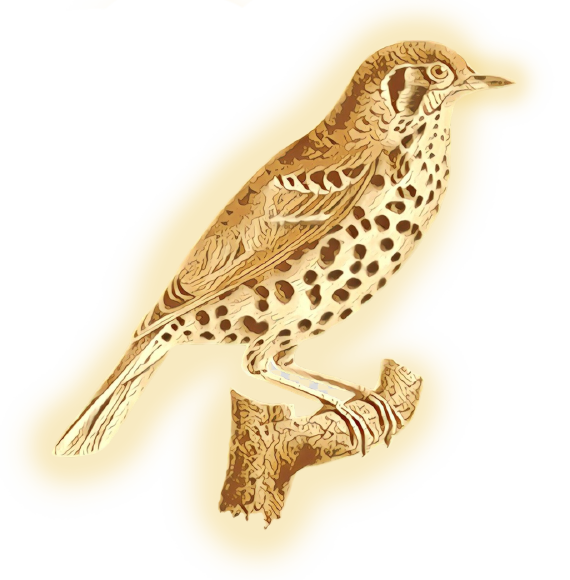Wings of Change
The Effects of Climate Change on Migratory Birds

Meet the Wood Thrush. Smaller than a Robin, the Wood Thrush makes its home throughout the forests of the Eastern United States.
While the birds aren’t frequently seen in urbanized areas, their singsong nature would be recognizable to most who’ve spent time hiking or live near a wooded area:
Michael Andersen / Macaulay Library at the Cornell Lab of Ornithology (ML125223)
The Wood Thrush survives off a diet of insects and small fruits, eating copious amounts to fuel migration each year.

The Wood Thrush is a long distance migrant, spending springs and summers breeding in the eastern United States. In fall, it migrates to central America, taking on a lengthy journey and tackling amazing feats like crossing the Gulf of Mexico in a single night’s flight. In the early spring, it makes the same lengthy trip back to the Northeastern forests. Since these journeys are so strenuous, the availablity of ripe fruit and insect populations greatly impacts the distance of its trips. Source

In the last 30 years, the Wood Thrush population has become more and more densely populated in the Northeastern United States. This can be seen in the maps below, as the more Southern and Western population clusters are moving North and East. This is likely due to these already warmer areas becoming too hot for the Wood Thrush to find sustainable nutrition. This loss in habitable areas is projected to continue, as “the Wood Thrush is on track to be declining or completely wiped out from 90% of its range under the worst temperature increase scenario.” Source
1990
2000
2010
2020
The southern US has become drastically warmer over the last few decades, especially in the last ten years. A warmer climate has many adverse effects on the Wood Thrush and other migratory bird populations. Loss of habitat will be common due to rising sea levels and increased rate of drought and wildfires. Rising temperatures also affect precipitation and vegetation, which in turn will affect the Wood Thrush’s food supply. If United States temperatures continue to rise at their current rate, “the ranges of [birds’] habitats may move closer to the poles or higher elevations.” Source
The map below shows both the average temperature in a US county and a sample Wood Thrush population for a given year. The sample population on this map above can be seen moving further north east over time.
1990 1995 2000 2005 2010 2015 2020
Wood Thrush Population and US Average Annual Temperature, 2020
Change in Average Migratory Distance

Over the last 30 years, the Woodthrush has seen a significant drop in migratory distance. This can be attributed to the increasing inhospitality of the far north breeding grounds and the southern wintering grounds. In central America, the Wood Thrush encounters acid rain, which depletes calcium levels from soil, and habitat shrinkage due to tropical deforestation. In Northern breeding grounds, less nutricious food sources can leave birds hungry and increase exposure to predators like racoons and crows.
We can see the impacts of rapid environmental extremes in the migratory distance of the birds. As the United State’s average temperature is increasing, we notice a severe drop, roughly 500 miles, in the distance traveled by migrating birds.
Movement North
The eBird system has significantly expanded over the past 10 years as mobile connection became the standard of communication around the world. As a result, eBird saw a tremendous increase in bird watcher participation, therefore keeping a more accurate record of bird sightings around the United States. Over this same time period, there has been record shifts in the average monthly latitude of Wood Thrush sightings.
The rapid decrease in habitable forests in the bird’s wintering grounds has led to a latitude increase of about 100 miles, roughly equivalent to 18 times the height of Mount Everest. In the summering months, there is still a significant, but notably smaller, increase in average latitude, probably due to the more significant breeding-time movements from the midwest to the more eastern states instead of strictly moving further northward. Source
Top 10 States with Most Observations, 2020
The proportional ratio of sightings between Northeastern and non-Northeastern states further illustrates the shfting migration trends of the species over the past two decades. The numbers in the two regions gradually grow and grow in disparity, with numbers in the 21st consistently composing the majority of sightings. This trend is observed again by looking at three different snapshots of total sightings in Northeastern vs. non-Northeastern states in 1990, 2005, and 2020:



To observe the trend over the past two decades, use the time slider to adjust by year.

The Role of the Wood Thrush
The Wood Thrush is a cornerstone of the ecosystems of North American forests. The species regulates the insect populations of species they consume, and by extension the vivacity of forest vegetation. The bird also disperses the seeds of the various fruits they eat,further increasing tree coverage.
As a result, the impact of the Wood Thrush on human life may be difficult to observe day to day, but is nonetheless significant. Its seed dispersal means that humans have access to more plants that can be used as food, medicine, or timber, and its migration patterns also provide key environmental data that can be used to signal and detect environmental changes in the North American climate.
Warming global temperatures, primarily due to human activity, have dramatically affected the habitats of Wood Thrush and many other bird species, but this is an often overlooked aspect of communicating climate change to humans. So, the next time you hear the familiar songbird call of the Wood Thrush, think, what am I doing to help the conservation efforts towards birds and the many other animals who inhabit the Earth alongside us? Source